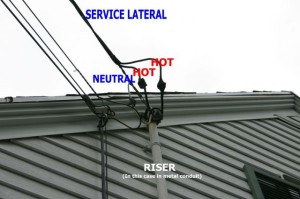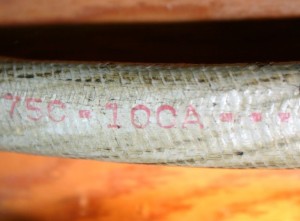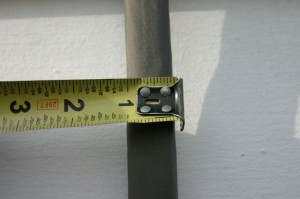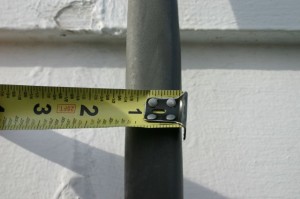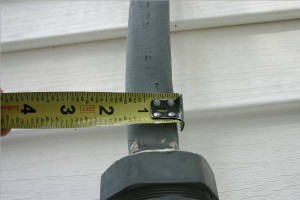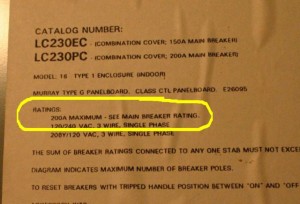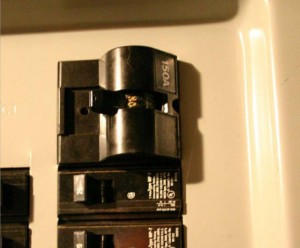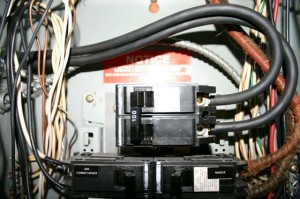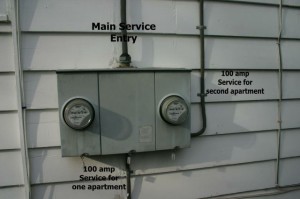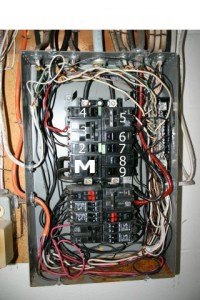Electric Service Capacity
Determining the Capacity of a Residential Electric Service
This article will provide an understanding of how to determine the capacity of a residential electricservice. Quite often we are asked the seemingly simple question “What is the size of my electric service”? In most cases this is a simple question to answer, as long as one knows what to look for.
Volts vs. Amperes First, it is important to understand that the capacity of an electric service is measured in amperage or current, not in volts. Amperage is the flow rate of the electrical current that is available. A home with 150 amp service can operate more electrical appliances than one with 100 amps. Our reliance on freezers, kitchen appliances with clocks, timers and artificial intelligence, charging stations for cell phones/PDA’s, large TV’s, stereos, fans, dishwashers and a host of other consumption devices have all but rendered a 100 amp service obsolete. Now we are beginning to charge our automobiles! A 200 amp service is the new normal in new construction. Residential electric services enter buildings in two forms, 120 volts and 240 volts. These are nominal numbers, which means that the actual voltage in the house can vary. Often times, 240 volt electric service is referred to as “220”. Almost all houses have both 120 volt service and 240 volt service (these can also be referred to as 110 volt and 220 volt). 110 voltage can be used interchangeable with 120 volts, and 220 voltage is interchangeable with 240 volts. To help understand the difference between volts and amperes, the electric service can be compared to the flow of water in a pipe. The amount of water flowing in a pipe is typically measured in a volume of water per unit measure of time. As an example, 10 gallons per minute of water may flow through a certain pipe. This flow rate of water is analogous to amperage or current in an electric wire. Current is the measurement of the amount of electric service that is “flowing” through the wire. The pressure of the water flowing through the pipe is not a measurement of the amount of water, but rather the amount of energy of the water inside the pipe. Similarly the voltage carried by an electric wire is a measurement of the amount, or type, of energy that is being carried. The amperage of an electric service is the capacity of the service, and the voltage of the service (120 volts or 240 volts) is a determination of the type of electricity that is available. In residential applications 120 volt service is utilized for lights, outlets, small appliances (such as microwave ovens, irons, toasters, clocks, televisions) etc. “220” volt service is utilized for larger electrical appliances such as air conditioning units, electric dryers, electric ranges, some electric heaters, etc. Almost all modern homes will have 220 volt electric service into the house. There are still a few houses around that do not have 220 volt capability at the present time. These are usually old homes that have not had electrical upgrades for a period of many years. These are rare. An easy way of determining whether a house has 220 volt or only 120 volt electric service would be to look at the overhead electric wire where it connects to the house (if it’s an underground service, it almost certainly has 220 volt capacity). The overhead wire is referred to as the service drop or service lateral. There are three wires. Two of the wires are “hot legs”, and there is a separate neutral wire. The neutral is usually bare metal, meaning that you can actually see the metal wire. The hot legs are insulated, typically with a black rubber covering. This overhead wire is connected to the electric service cable, or “riser” for the house at the point where the overhead wire is attached to the building. If all three wires are connected to the service “riser” that runs down the wall of the house, you can conclude that there is both 110 volt and 220 volt service for the house. This is because each of the “hot legs” carries 120 volts, together providing 240 volt or “220”, to the house. To the contrary, if one of the hot wires for the overhead service is not connected to the riser cable on the house (but instead is just tied back loosely) then the house is only provided with 120 volt service. Once again, this would be rare. Usually these houses only have 30 ampere capacity for the electric service, and the electric panel is a very old fuse panel. It is important to note that even most fuse panels that remain in use today do have 220 volt service.This photo shows an overhead service with 240 volt capability. Note that both “hot” wires are attached. If one of them were not connected, the house would only have 120 volt service.
Determining the Capacity of the Service: The electric service capacities that one might see in residential buildings are 30 amperes, 60 amperes, 100 amperes, 125 amperes, 150 amperes, and 200 amperes. In a few instances the capacity is greater than 200 amperes, but this would only be the case for large modern upscale homes with greater electrical needs. We offer the following in regard to these various capacities:- 30 Ampere. As discussed above, 30 ampere service has become quite a rarity. A 30 ampere service would only be of 120 volt capability. Those rare cases where 30 ampere service is found would be small older homes that have been lived in by the same family or person for a very long time, and the need for modernization or upgrade has not presented itself. This service is considered inadequate and unsafe for modern living.
- 60 Ampere. This is typically the lowest capacity for a 120/240 volt service, but it is sometimes only 120 volt. This capacity is considered to be marginal at best for modern living. Quite often, 60 ampere service also includes the presence of an old fuse panel, as opposed to the more modern circuit breaker panel.
- 100 Ampere. A large number of existing average size homes has 100 ampere capacity electric services. Average size homes with gas or oil heating systems and hot water systems generally do not need an electric service greater than 100 amperes capacity. Of course, this can also depend on the electrical usage of the occupants, and the use of other electrical appliances.
- 125 Amperes. These are not as common and will be discussed at the end of this document.
- 150 Amperes. Common practice is such that this has become the typical minimum that might be installed in modern construction for a single family home or for an upgrade in an existing home.
- 200 Amperes. This is becoming the norm for modern single family residential construction and upgrades. In many instances it is not a necessity, but it is installed routinely in new construction.
Sometimes the actual capacity of the service entry cable is printed directly on the cable. Unfortunately this is not common, but when looking at some cables you will see “100A” or “150A”. This easily identifies the capacity of the cable. More often, the capacity of the cable can be estimated by the size of the cable:
– 60 ampere capacity cables are between 3/4 and 7/8 inch wide.
– 100 ampere capacity cables are approximately 1 inch wide.
– 150 ampere capacity cables are approximately 1-1/4 inches wide.
– 200 ampere capacity cables are typically 1 and 1/2 inch wide.
The width of the cable can vary depending on whether it is a copper (older) or aluminum cable, and also depending on the material of the outer jacketing.
This cable is labeled as 100 ampere
While this 100 amp cable is 1” wide
150 amp cable
200 amp cable
Panel Rating The rating of a panel is usually indicated on the label inside of the panel door. Sometimes the label is inside the panel, and you would have to take the panel cover off to gain access. This is not recommended unless you are very familiar with working with electricity and opening electric panels. These labels will typically indicate “200 amp max. capacity” or “100A maximum capacity”.The label in this panel indicates 200 ampere max capacity
Capacity of Main Disconnect Most modern panels have a single main disconnect. Often times, this disconnect is labeled as the “main”. The capacity of the unit is labeled on the disconnect. It will typically indicate “100A”, “150A”, or “200A”. This is not true with split bus panels and older fuse boxes (this will be discussed below).150 amp main
100 amp main
As you can see from the above, if you were to see that a panel is rated at 150 amperes maximum, and it is equipped with a 150 ampere main disconnect, and it is fed by a 150 ampere cable, you can conclude that the service is 150 amperes capacity. There are instances when the three determining factors are not equal. For example, if a 100 ampere capacity cable is feeding a 150 ampere capacity panel with a 150 ampere capacity disconnect, the service would be considered a 100 ampere capacity service. The cable would be the limiting factor. In addition, this would be an unsafe condition since the cable would not be of large enough capacity to withstand the potential for 150 amperes of current that would be permitted by the panel and disconnect. The cable would be considered as undersized and replacement with an appropriately sized cable would be recommended for safety reasons. On the other hand, a 150 ampere cable feeding a 100 ampere capacity panel and disconnect would be considered a 100 ampere capacity service and it would also be considered safe (the cable can be oversized but it cannot be undersized). Multi-family Buildings It is often times the case that multi-family residences have separate or individual electric services for each apartment. In these cases it is common for a single large service entry cable to feed a number of electric meters. Each individual meter then feeds each individual electrical panel. The capacity of the service for each apartment is determined by the lowest capacity of the cable feeding each of the individual panels, the rating of the individual panels, and the disconnect. It is not uncommon for individual apartments to have a service capacity of 60, 70, or 100 amperes.Electric service for a 2 family house
Split Buss Panels Confusion sometimes arises when the use of split buss panels comes into play. These types of panels were utilized with great frequency around the 1950’s and 60’s. They are not equipped with a single disconnect, although there is usually a circuit breaker labeled as a “main”. The electric service connection into a split bus panel will simultaneously provide power to two, three, four, five, or six disconnects (fuses or breakers). The fuse or circuit breaker that is labeled as “main” simply controls the power to some of the other circuits. For a split buss panel the size or capacity of the service is determined by the size of the cable and the rating of the panel (since there is no single main disconnect). It is very common for split buss panels to have a rating of 125 ampere maximum capacity. It is also common for these panels to be fed with a 100 capacity cable. This service would be considered of 100 amperes capacity (as dictated by the cable). 125 ampere capacity services are rare due to the fact that 125 ampere capacity service entry cables are a rarity. Electrical codes for existing services do not require that a panel be equipped with a single main disconnect. This is why split buss panels remain in use today. They are not utilized for new installations, but many of the panels are still in use. Electrical standards do limit the number of main disconnects to six. This is commonly referred to as the “6 throw rule”. What it means that one must be able to turn off all the electric service to the house with no more than 6 main disconnects.This is a split bus panel. The upper section has the disconnect. The disconnect that is labeled “M” shuts off the lower section of breakers. Those labeled 2 thru 9 are individual disconnects. This panel violates the 6 throw rule.
The Building Inspector
